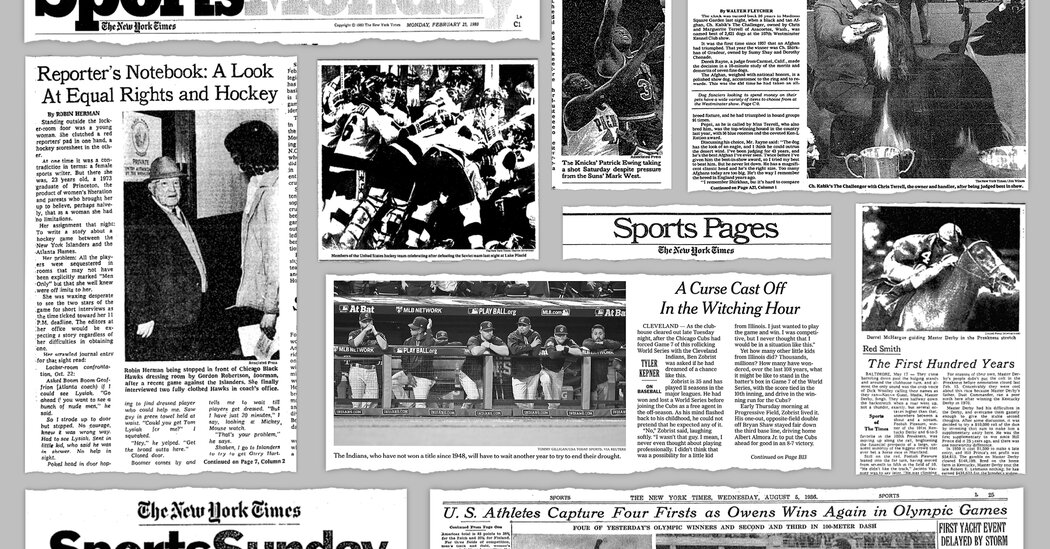
Scenes From More Than a Century of Sports
Times Insider explains who we are and what we do and delivers behind-the-scenes insights into how our journalism comes together.
At the first modern Olympics, in Athens in 1896, The New York Times was there to chronicle the presence of the king of Greece and the duke of Sparta, the hills “black with spectators” too poor to pay for tickets and the triumph of American athletes (“they won their victories with much apparent ease”).
Since then, hardly a milestone in sports history has gone by that a New York Times reporter has not covered.
The sprinter Jesse Owens’s four gold medals at the 1936 Berlin Olympics. The “Miracle on Ice” during the 1980 Winter Olympics in Lake Placid, N.Y. The Chicago Cubs’ World Series victory in 2016, which broke a 108-year drought.
But there will be no Times sportswriter in the press box at Madison Square Garden this season.
Last week, The Times disbanded its Sports department, though it will still provide coverage of teams and games through The Athletic, the sports website The Times bought last year.
As journalists from the Sports desk began other assignments across the newsroom — and, in a few cases, roles at The Athletic — Times Insider took a look back at the history of the desk. New York Times Sports has been home to a distinguished lineup of columnists — among them Arthur Daley, Red Smith, Dave Anderson and Selena Roberts — as well as reporters like Alan Schwarz, whose reporting on the deadly effects of concussions in the National Football League led to reforms at all levels of the game.
Here are five occasions when Times sportswriters and columnists went the extra mile for a story.
Carving Out a Unique Beat
Walter Fletcher joined The Times’s staff in 1927 soon after graduating from City College of New York, where he was the campus correspondent for The Times and The New York Post. At The Times, Fletcher, a lifelong dog enthusiast, turned his interest into a beat: covering the dog-show world.
Over the more than 40 editions of the Westminster Kennel Club Dog Show he covered in his more than 60 years writing for The Times, he demonstrated a knack for, well, being right — correctly predicting the Best in Show winner in each of the seven years leading up to his retirement in 1995 (take that, Paul the Octopus).
“He cared about the sport and knew about it,” Roger Caras, the president of the American Society for the Prevention of Cruelty to Animals, told The Times in 2000. “He had a sense of humor. I once called him the Walter Lippmann of the hydrant set, and he loved it.”
Red Smith’s Search for Sideshow Stories
Red Smith wrote for The New York Herald Tribune for 21 years and was a nationally syndicated columnist before he arrived at The Times in 1971, at age 66. So when he took over the Sports of The Times column, he essentially had carte blanche to cover whatever he wanted.
What he actually wrote about: the small talk Muhammad Ali made with the music legends James Brown, Billy Eckstine and Lloyd Price and the comedian Redd Foxx the day before defending his world heavyweight championship title against Chuck Wepner in 1975; the legacy of Black Gold, a horse that won the Louisiana and Kentucky Derbies in 1924; and the love affair between pro baseball players and chewing tobacco.
Smith, who was awarded the Pulitzer Prize for commentary in 1976, was sought after by dictionary and thesaurus publishers as an editor or an adviser thanks to his literary writing style and mastery of the English language. He made it his mission to spotlight overlooked people and perspectives in professional sports.
Fighting for the Right to Be in the Room
Until the 1970s, female sports reporters were barred from locker rooms in men’s professional sports, meaning they had to wait until players were dressed after games to conduct their interviews, while facing the same tight deadlines as their male colleagues.
Robin Herman, a hockey reporter for The Times, would not accept it.
After becoming one of the first female journalists to enter a men’s professional sports locker room at the National Hockey League All-Star Game in Montreal in 1975, she pressed teams across the N.H.L. to give her access to their locker rooms while covering Islander road games. It didn’t happen right away, and even when it did there were challenges, including crude remarks, dropped towels and reams of hate mail (“It’s hard to address a harlot disguised as a reporter,” one letter read).
But she pressed on — the last holdout, the Toronto Maple Leafs, continued to bar female reporters as late as 1987 — and eventually her efforts opened doors for other women covering professional sports.
Creating a New Storytelling Form
When the sports reporter John Branch began looking into the details of a deadly avalanche in Washington State in 2012, he had no inkling that anything would be different about the presentation of his final article.
But after Branch, who spent months interviewing survivors, families of victims and first responders, shared with his editors a minute-by-minute timeline of the disaster, they sent the file to the heads of the Graphics, Photography and Video departments at The Times. And that, he told a student at the University of Southern California in 2014, was when the size and scope of the project grew dramatically.
In a collaboration that would reshape multimedia journalism for the next decade, Branch worked with a team of 11 editors and designers to combine more than 15,000 words with video interviews, interactive graphics and animated simulations. The project, “Snow Fall: The Avalanche at Tunnel Creek,” which was viewed by more than 3.5 million people after it was published, went on to win the 2013 Pulitzer Prize for feature writing.
Five Columns in Eight Hours
There’s writing fast, and then there’s what Tyler Kepner, the national baseball writer for The Times, pulled off during the Chicago Cubs’ triumph in Game 7 of the 2016 World Series in Cleveland.
With the Cubs leading, 6-3, in the eighth inning, and the lead seeming safe, Kepner polished off a “Chicago makes history” column, in time to make the next day’s paper.
But then.
Cleveland’s Rajai Davis hit a home run to tie the game, and Kepner filed another column about Davis’s unlikely heroics — written in about 12 minutes, his editor, Jay Schreiber, recalled at a recent going-away party for Kepner, who earlier this month began a new role covering Major League Baseball for The Athletic.
But the Cubs weren’t done yet: In the top of the 10th inning, Ben Zobrist hit a double to put Chicago back in front. The Cubs tacked on another run, and Kepner filed a third column.
Finally, he caught a break: The Cubs held on, capturing their first World Series championship in 108 years, and a column featuring Zobrist made the paper’s delayed final edition.
“With a Curse-Breaking Hit, Ben Zobrist Lives a Dream He Never Expected,” read Kepner’s fourth column, filed (“pristinely,” Schreiber recalled) around 3:30 in the morning.
And then, as the sun rose, came the last gasp, Column 5, about Cubs first baseman Anthony Rizzo, who caught the last out of the game.
Kepner’s column ran on the front page of the next day’s paper. And, having filed five columns in around eight hours — a feat made possible only by his preparation and encyclopedic baseball knowledge — he headed back to his hotel to get some sleep.









